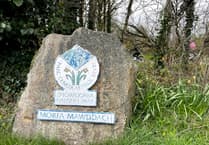‘Alarming’ data estimates the seas and waterways in parts of Gwynedd saw the second highest number of sewage discharges in England and Wales last year.
Data from water provider Dŵr Cymru and environmental regulator Natural Resource Wales (NRW) shows there were 6,952 dumps in the Dwyfor Meirionnydd constituency in 2021.
Analysis by website Top of the Poops claims these equate to nearly 70,000 hours of effluent being spewed into the region’s rivers and seas – equivalent to just over eight years.
It is estimated there were a further 3,700 discharges in Arfon in the northern most region of Gwynedd County – the 19th most in England and Wales.
The analysis also estimates the frequency of discharges in particular rivers and coastlines in both Ceredigion and Gwynedd.
Plaid Cymru MS for Dwyfor Meirionnydd, Mabon ap Gwynfor, called for greater investment to improve infrastructure so storm overflows are no longer required.
Welsh Water does not dispute the data but says it has not yet verified the analysis despite it being in the public domain for more than a year.
Gwynedd, which contains almost the entirety of Snowdonia National Park, is known for its sprawling countryside, mountains, sandy beaches and cascading rivers.
The tourist destination’s famous beaches, including Aberdyfi, Tywyn, Barmouth and Morfa Nefyn, among others, attract thousands of visitors every year.
Top of the Poops estimates there have been 129 separate storm overflows into the Dyfi river which acts as the natural border between Ceredigion and Gwynedd.
Its source is in Lake Creiglyn Dyfi in the Snowdonian mountains and it flows for 30 miles down to the coast between Borth and Aberdyfi, passing Machynlleth in Powys.
It was pumped with sewage for more than 1,100 hours last year, data suggests.
But Morfa Nefyn beach on the northern coast saw the ninth longest duration of total sewage discharges in the country and the most of any beach in Wales.
There were 445 overflows last year which totalled 4,300 hours of sewage being spewed onto the coastline.
Barmouth beach, which is about 20 miles south of Morfa Nefyn, saw 210 separate incidents which flowed for nearly 550 hours.
Llandanwg beach – which sits between towns of Barmouth and Harlech – also saw more than 200 overflows.
Mr ap Gwynfor said: “There is no reason why we should be seeing raw sewage leaking into any body of water.
“Storm surges will lead to the infrastructure being unable to cope with the increased volume of water.
“But that only strengthens the case for greater investment in maintaining and improving the infrastructure.
“We will keep in contact with Dŵr Cymru and the Welsh Government’s regulatory bodies to ensure we have the cleanest water possible here.”
Gwynedd Council declined the opportunity to comment on the practices.
Marine conservation charity Surfers Against Sewage (SAS) developed an app called Safer Seas & Rivers which provides daily updates on the water quality at more than 400 coastlines and waterways.
In the last few months, the Dyfi estuary area along with other west Wales beaches were categorised as unsafe on several occasions by the charity after a series of pollution incidents.
An SAS spokesperson said: “Sewage pollution is a blight on our rivers and coastline all across the UK and the beaches of west Wales are certainly no different.
“We are calling on government and regulators to act in the interests of people and planet and crackdown on the profiteering water companies.
“For far too long they have used our precious blue spaces as sewers with a chronic failure to invest in vital infrastructure.
“We demand an end to sewage pollution and we demand it now.”
Welsh Water, like others in the sector, has been criticised over the inflated pay packages for its executives, even despite its status as a not-for-profit company.
Based on its 2020-21 accounts, Peter Perry who was appointed chief executive officer in 2020, took home more than £500,000 in salary and bonuses last year. Other senior figures made well over £300,000 in total.
But the company does reinject all the profits it makes back into repairing the network, which is more than can be said for the water firms in England.
English firms are often condemned for the huge shareholder dividends which are paid, opponents say, at the expense of repairing archaic pipelines, bringing prices down and fixing other problems with the network.
But it would appear Welsh residents pay a premium for the service, as the company charges the second highest bills of any water firm in England and Wales – behind only South West Water – according to Statista data.
A Welsh Government spokesperson said: “We are committed to working with all organisations and sectors to improve the quality of Wales’ waterways.
“We have provided £40 million for a programme of works over the next three years and established a new taskforce that brings together regulators, government and water companies to improve water quality.
“Collaborative working is key and the new group will allow us to address the various threats our water bodies face together including the effective management of sewers.”
Here’s what Welsh Water had to say...
“In the short time provided to respond to this article, it has not been possible to validate the spill numbers quoted by Top of the Poops. We submit our spill numbers annually to our regulator NRW and these are always available to view on our website by anyone at any time.
“It is important to be clear from the outset that the higher spills numbers from our Combined Storm Overflows (CSOs) does not mean that Welsh Water is a poor performer in this area and the numbers must be viewed in the context of two key facts.
“Firstly, Welsh Water is committed to protecting bathing and river water quality and has invested over £8 million on installing monitors on its CSOs to record spill numbers. The company now has monitors on 99.5 per cent of its CSOs which exceeds the coverage of other water companies. This means that Welsh Water has much more data to report on its CSOs to its regulators and so it’s unsurprising that it records larger numbers of spills than others.
“Secondly, due to its geographical location on the British Isles, Wales naturally receives more rainfall than other parts of the UK. As CSOs are designed to operate during heavy rainfall to help protect communities from flooding, our CSOs operate more frequently. Snowdonia National Park for example is amongst the wettest places in the UK and to bring this to life, in February 2020, Capel Curig saw 224mm of rain for the month compared to the UK average of just 97mm of rain. Currently the average spill number for Welsh CSOs is around 33 times per year. If we had the rainfall of Cambridge for instance, the average spill number would be 13 times per year. Their operation is a function of the rainfall we receive in Wales.
“We recognise however that with environmental legislation tightening and customer expectations changing, more needs to be done. Removing CSOs from our system is not an option but what is in our control is the ability to target investment to CSOs which have the biggest impact so that we can improve their performance. That is why we are investing £936 million to 2025 on further improvements to our network.
“Welsh Water has always taken its responsibility for operating CSOs responsibly and invested more than £1 billion as testament to this over the years. This has delivered real improvements and helped ensure that Wales has over a third of the UKs Blue Flag beaches while only having 15 per cent of the coastline.”
Have you found water in your area to be unexpectedly dirty? Send your videos and photos to [email protected]








Comments
This article has no comments yet. Be the first to leave a comment.